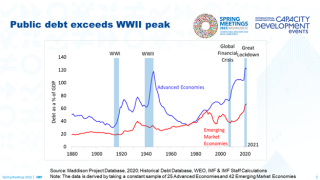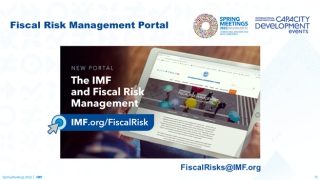Image provided by IMF Capacity Development/ LinkedIn
Article originally posted on IMF Capacity Development | LinkedIn - Building Capacity on Managing Fiscal Risks (linkedin.com)
Posted by Lesley Fisher and Amanda Sayegh[1]
Our world today has been beset by crises we could not have anticipated 3 years ago: a global pandemic, large-scale supply chain disruptions, and a war in Ukraine. These crises have had, and still are having, devastating impacts, causing loss of life and economic upheaval.
They have also impacted on public finances, as governments have taken steps to shield their citizens and economies from the worst effects. These challenges are taking place against a backdrop of high debt, limited fiscal space, and elevated uncertainty.
We cannot predict what events may develop next year, or the year after. But policymakers can structure public finances with resilience in mind.
What can governments do to better understand, manage, and prepare for fiscal risks?
Fiscal risks are all those factors that can cause government finances to deviate from what we expect – events like pandemics, recessions, financial crises, climate change or natural disasters. As many countries have experienced, the past two years have demonstrated how costly fiscal risks can be. Collectively, we’ve just been through one of the biggest shocks in a generation. The COVID-19 pandemic has had deep implications for global populations, economies, and public finances.
In many of your own countries, we saw public debt rise to levels not seen before. In fact, the pandemic contributed to the largest one-year increase in global public debt in 50 years.
After two major crises, total public debt is higher than the peak of the second World War-.This increase in debt—to about 100 percent of GDP—was largely caused by an unexpected turn of events, or what we call fiscal risks.
And fiscal risks remain elevated. Countries are now facing new risks arising from the war in Ukraine, the displacement of people in Europe, and rising food and energy prices everywhere. At the same time countries are also grappling with challenges posed by climate change, including an increased frequency and severity of natural disasters.
We have also come to understand that it’s not just extreme events like these that are cause for concern. Fiscal risks that become reality occur with surprising frequency. Pressures can arise from volatility in commodity prices, impacting revenue and the cost of imported goods in the budget, decisions to bail out troubled state-owned enterprises, or calls on government guarantees.
We also know, that when it rains it pours – in difficult times, one shock tends to trigger others, causing different risks to all materialize at once.
IMF research has shown that on average it seems that countries face a macro-critical event about once every 12 years, each resulting in fiscal costs of around 6 percent of GDP.
This underscores how important it is that countries understand the nature and size of the risks they face and take steps to manage them.
Establishing Sound Risk Management Systems
First, policymakers should identify their fiscal risk exposures and prioritize those that are most important. Second, they should try to quantify the magnitude of those risks as well as their likelihood of occurring. Third, they should consider whether actions need to be taken to mitigate exposures. For example, by imposing caps on guarantee schemes, or regulating certain activities. Fourth, governments can create fiscal buffers to accommodate risks. For example, some countries choose to include contingencies in their budget for unanticipated events, others have established stabilization funds with dedicated assets on which they can call in times of crisis.
And finally, it’s important that risks are reported transparently. Disclosing known fiscal risks can help underpin credibility and send a signal that governments are not only aware of those risks but are taking steps to manage them as well. The IMF’s Fiscal Transparency Code and Handbook provides useful guidance on good practices for disclosing fiscal risks.
At the same time, risk management practices should be integrated into the broader public financial management framework. Integrating decisions into the annual budget process, helps ensure that policy makers are made aware of the expected costs of interventions when decisions are taken, and that those costs are included in budget planning. Fiscal risks should also be factored into the design of fiscal rules, and systems established to monitor how risks may evolve over time.
Experience has shown us that countries which have sound risk management practices in place are better able to weather crises when they hit. Deciding which risks to focus on can be daunting. So where should you start?
The IMF has launched a new Fiscal Risk Management Portal – a one-stop-shop where you can access our latest resources and tools. It includes a Knowledge Hub which brings together the IMF’s guidance, latest research, and country examples. And a new Fiscal Risk Toolkit which provides a practical basis to help countries identify, assess, manage, and disclose different sources of risks.
The Toolkit includes a number of excel-based templates to help you identify your largest and most important sources of fiscal risks and to quantify their potential fiscal impacts. These tools can also be tailored to match your government’s capacities and your country’s circumstances. The Fiscal Risk Assessment Tool is a good starting point for governments who are new to fiscal risk management.
The tool is intuitive and contains a guided questionnaire on 14 fiscal risks to support your analysis, including macroeconomic, environmental, guarantees and other sources. The tool helps you to better understand your risk exposure, so you can prioritize your risk monitoring and management efforts. The tool also provides global and regional comparisons that may be useful in benchmarking your risk exposure.
The Fiscal Risk Toolkit also contains several tools to support more in-depth analysis of specific risks, such as state-owned enterprises, public guarantees and loans, public private partnerships, and pandemics.
For example the two state-owned enterprise tools can help you assess vulnerabilities and risks across the sector:
- the Health Check Tool provides high level analysis that can be used to identify those entities that may require closer attention
- the Stress Test tool allows you to dig a little deeper and assess the resilience of a particular entity under different scenarios and to quantify the fiscal costs that may arise
You can download these and other tools on the Fiscal Risk Portal, and apply them to your own countries’ data and circumstances. These tools have been informed by the IMF’s capacity development work with individual countries.
At the IMF's Capacity Development Talk on Building Capacity on Managing Fiscal Risks at the Spring Meetings, representatives from the Ministries of Finance of the Odisha State in India and Zimbabwe shared their experiences working with two of the tools.
Vishal Dev, Principal Secretary for Finance for the State of Odisha in India explained how the state has used the IMF tools to identify fiscal risks and develop a comprehensive report on their exposures and mitigation strategy.
And Eria Hamandishe, the Director of Economic Policy in the Zimbabwe Ministry of Finance and Economic Development, talked about the way in which the country worked with the IMF to bolster its fiscal risk analysis.
Prepare for the Unexpected
We know that many countries’ budgets are strained, and that they have limited fiscal space. Fiscal risk management should therefore be integral to public financial management.
We also know that fiscal risks are already elevated, and we face an uncertain period ahead. We don’t know the timing and magnitude of the next big event, but we know there is a high likelihood that something unexpected will happen.
If we have learned anything from the past two years, it is this: if you take action to better understand and manage your risks today, you will be more prepared to withstand shocks in the future. To quote a well-known author: “there’s no harm in hoping for the best, as long as you’re prepared for the worst”.
This article was written by Lesley Fisher and Amanda Sayegh, Senior Economists, IMF Fiscal Affairs Department, and derives from the abovementioned CD Talk.
Note: The posts on the IMF PFM Blog should not be reported as representing the views of the IMF. The views expressed are those of the authors and do not necessarily represent those of the IMF or IMF policy.









